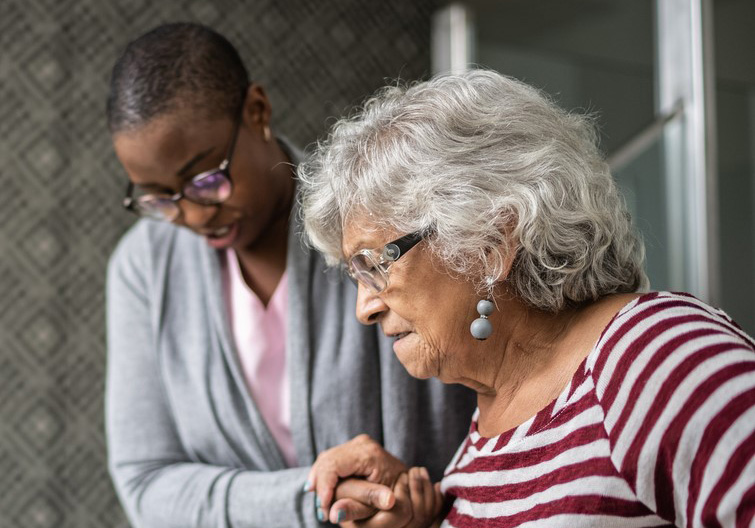People from the most deprived areas of Leeds, living with long term physical and mental health conditions, are contributing to a revolutionary research project to inform how health and care services could better meet their needs.
Phase one of this work, known as ‘SEISMIC’, was funded by the National Institute for Health and Care Research (NIHR) and the UK Research and Innovation Engineering and Physical Sciences Research Council (EPSRC) from July 2023 – August 2025 [1] [2].
Designing new and effective models of care, personalised to people with the greatest needs, SEISMIC forms the basis of a new innovation hub and future citywide approach for health system transformation.
A SEISMIC shift
Multiple long-term health conditions affect around 14 million people in England, occurring 10 – 15 years earlier for people living in the poorest areas.
As well as significantly impacting quality of life, more and more people are living with multiple long-term conditions – placing huge demand on the NHS.
Caring for people with multiple conditions can be challenging due to interactions between different conditions. Care can be fragmented because many services in the NHS have been built around single conditions, doctors train in specialties and research tends to take place on one disease at a time.
People with multiple conditions want joined up, efficient and easy to navigate care, as well as better support for mental wellbeing.
In Leeds, nearly 180,000 people have two or more long-term health conditions. A quarter of these people live in parts of the city which are among the country’s most deprived areas [3].
The city has moved to better join up local health and care services via the Leeds Health and Care Partnership – and this collective approach is also helping to embed research within health and care for the benefit of local populations.
SEISMIC combines systems design and engineering expertise with data science and insights from the health and care system. This radical approach means teams in Leeds can now better understand the problems that people living with multiple long-term conditions experience – and how to improve health and care services for them.
Phase one of the work has created a revolutionary, transferable model for longer term research collaborations. Crucially, it sees academic and healthcare partners come together to directly respond to city health needs, improving the lives of local people and creating a blueprint to transform care in the future.
Out-of-the-box thinking to unlock innovation
An aerospace engineer working with healthcare professionals may sound like an unlikely partnership. But in Leeds, out-of-the-box thinking brings these unconventional collaborations into being.
Phase one of the project brought together experts from patient and public involvement, health and care, mental health, mechanical engineering and socio-technical systems.
Project partners include the University of Leeds and Leeds Health and Care Partnership, with support from Leeds Academic Health Partnership, which is at the heart of Health Innovation Leeds. These leading organisations are working with a wide range of stakeholders, including local people who live in the most deprived areas of the city, to learn, redesign, test, evaluate and create an innovative new approach.
As part of phase one, partners established a framework to co-design change:
1 Articulate the vision
2 Understand the population
3 What is happening now and why?
4 What will resolve the problem?
5 Business case development
5a Pilot Implementation
5b Has the impact been as expected?
The perfect place for innovation at pace
So what makes Leeds a top location for health innovation – and an ideal place to transform care and quality of life for people living with multiple long-term health conditions?
- A citywide Healthy Leeds Plan which includes multiple long-term conditions as one of its priorities.
- A shared, cross-sector goal to reduce health inequalities.
- A citywide, multi-disciplinary, population health management approach, which groups people according to their greatest health needs, one of which is multiple long-term conditions.
- The Leeds Data Model: a national exemplar linking health and care data with other data sets, providing access to holistic insights for research.
- World-leading academic expertise in systems design, engineering and applied health research, including a £40 million NIHR infrastructure.
- A pioneering and collaborative approach to inclusive research, linking with the city’s large voluntary sector.
- A population diversity which reflects that of the UK, meaning projects can start small, trial new ideas and scale fast.
- A strong, established culture of cross-sector partnership working.
Building tomorrow’s healthcare today
In Leeds, mature partnership working and deep integration of data and digital are powering novel solutions to the most pressing health challenges of our time.
Reflecting national and local priorities, the Leeds Health and Care Partnership (representing the local Integrated Care Board ((ICB)) and wider partners) are leading the way when it comes to improving health outcomes and reducing health inequalities. A pioneering approach to population health planning includes use of data modelling to design and target interventions to prevent ill-health and understand what local people need – now and in the future.
This collective approach to population health management, underpinned by the nationally acclaimed Leeds Data Model, supercharged SEISMIC and set the stage for embedding new models of care.
Now, partners are building on phase one as a key transformation priority for the city.
As Leeds develops the scope and reach of its award-winning HomeFirst Programme – which saw significant impact in transforming intermediate care – partners will harness the innovative approach unlocked by SEISMIC to continue to build tomorrow’s healthcare today for those living with multiple long term conditions.
References
[1] SEISMIC stands for: Systems Engineering Innovations Hub for Multiple Long-Term Conditions.
[2] Phase one of the project – known as ‘SEISMIC’ – was funded by the National Institute for Health and Care Research (NIHR) and the UK Research and Innovation Engineering and Physical Sciences Research Council (EPSRC). Programme: Systems Engineering Innovation Hubs for Multiple long-term Conditions, Grant Reference NIHR158156.
[3] Index of multiple deprivation level 1: https://data.cdrc.ac.uk/dataset/index-multiple-deprivation-imd
More information
Phase one – ‘SEISMIC’ – development phases
Stage 1
Understand current practice and improvement opportunities
What is happening now, who / which services are involved, what is the service-user experience and what could be changed to transform this?
Stage 2
Co-create goals for future solutions and prioritise improvement opportunities
Work with all stakeholders to agree a new approach. Understand and agree the practicalities involved for making the most needed changes across the healthcare system.
Stage 3
Explore feasibility of potential solutions
Test and evaluate our solution across all stakeholder experiences and system processes and, based on what we learn, design a final prototype.
The views expressed are those of the author(s) and not necessarily those of the NIHR or the Department of Health and Social Care
Image credits:
Header image: iStock.com/FG Trade
Sideline image 1: iStock.com/Daniel Balakov
Sideline image 2: iStock.com/gorodenkof
Sideline image 3: iStock.com/kelvinjay



